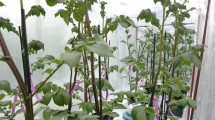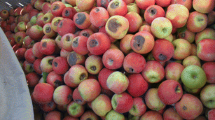Abstract
Surveys of eight carrot growing regions in South Australia conducted from December 1998 to May 1999, showed that poor seedling establishment was associated with high levels of infection by Alternaria radicina. Seedling losses were widespread throughout the state and were most frequent between February and April 1999. Up to 47% of seedlings and 88% of mature plants on some properties were infected by A. radicina. Isolations from diseased plants showed that A. radicina attacked carrots at all stages, causing damping-off, and rotting of roots, crowns, seedlings, petioles, leaves and crowns of maturing carrots. Up to 70% of mature carrots with crown and shoulder infections were unmarketable. Of the 19 lines of commercial seed tested, 18 were infected with A. radicina with the highest infection level of 35% occurring on imported seed. A. radicina at levels between 0.2 and 14% was also found in 11 of 16 seed batches treated with thiram and/or iprodione. Isolates of A. radicina from seeds or infected seedlings were pathogenic to carrot seedlings and carrot discs. Alternaria dauci was also isolated from two seed samples, with levels of infection ranging from 0.1–0.3%, and on foliage in three of the eight carrot growing regions.
Similar content being viewed by others
References
Barnett HL (1965) ‘Illustrated genera of imperfect fungi.’ (Burgess Life Science Series)
Davison EM, McKay AG (1998) Pythium spp. associated with cavity spot of carrots in Western Australia. Australasian Plant Pathology 27, 163–168.
Ellis MB, Holliday P (1972) Alternaria radicina No. 346. In ‘CMI Descriptions of pathogenic fungi and bacteria’. (Commonwealth Mycological Institute: Kew, Surrey, England)
Maude RB (1966) Studies on the etiology of black rot, Stemphylium radicinum (Meier, Drechsl. & Eddy) Neerg., and leaf blight, Alternaria dauci (Kühn) Groves Skolko, on carrot crops; and on fungicide control of their seed-borne infection phase. Annals of Applied Biology 57, 83–93.
Pryor BM, Davis RM, Gilbertson RL (1994) Detection and eradication of Alternaria radicina on carrot seed. Plant Disease 78, 452–456.
Pryor BM, Davis RM, Gilbertson RL (1998) Detection of soil borne Alternaria radicina and its occurrence in Californian Carrot Fields. Plant Disease 82, 891–895.
Pryor BM, Davis RM, Gilbertson RL (2000) A toothpick inoculation method for evaluating carrot cultivars for resistance to Alternaria radicina. Horticultural Science 35, 1099–1102.
Soteros JJ (1979) Pathogenicity and control of Alternaria radicina and A. dauci in carrots. New Zealand Journal of Agricultural Research 22, 191–196.
Strandberg JO (1987) Isolation, storage, inoculum production methods for Alternaria dauci. Phytopathology 77, 1008–1012.
Author information
Authors and Affiliations
Corresponding author
Rights and permissions
About this article
Cite this article
Coles, R.B., Wicks, T.J. The incidence of Alternaria radicina on carrot seeds, seedlings and roots in South Australia. Australasian Plant Pathology 32, 99–104 (2003). https://doi.org/10.1071/AP02069
Received:
Accepted:
Issue Date:
DOI: https://doi.org/10.1071/AP02069




